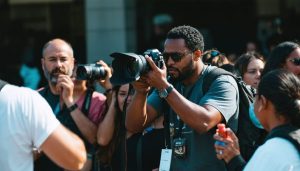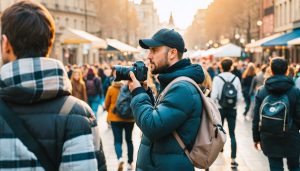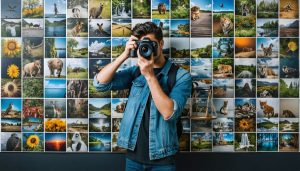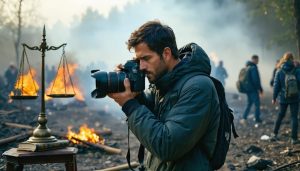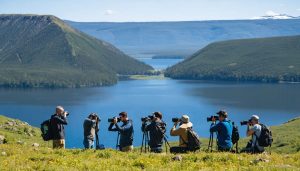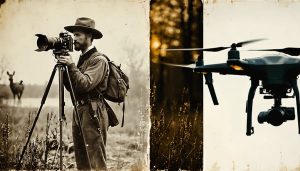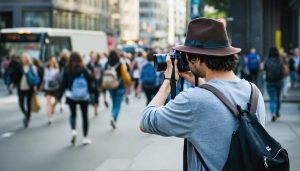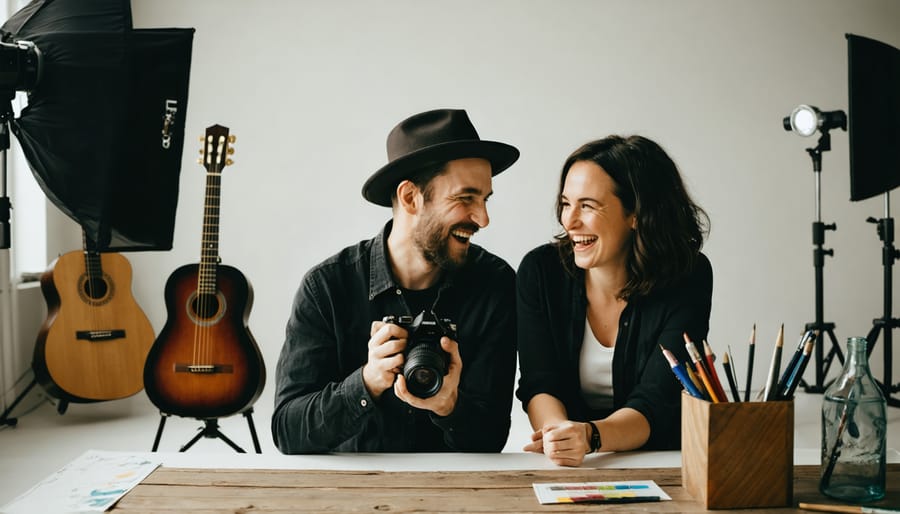
Every powerful photograph tells a story beyond its visual elements. Whether capturing the subtle interplay of light across a subject’s face or freezing a decisive moment in time, storytelling through photography demands both technical mastery and deep human connection. Understanding the ethics behind the lens transforms ordinary portraits into compelling visual narratives that respect and elevate their subjects.
The most memorable images speak volumes without uttering a word – they capture authentic emotions, reveal hidden truths, and forge lasting connections between viewer and subject. By mastering the delicate balance of composition, timing, and human interaction, photographers can create visual stories that resonate deeply while maintaining the dignity and agency of those they photograph.
This exploration of photographic storytelling will equip you with both the technical foundations and ethical framework needed to craft images that don’t just document moments, but bring stories to life through your unique creative vision. From essential composition techniques to building genuine rapport with subjects, we’ll discover how to create photographs that captivate, communicate, and endure.
The Power of Visual Narratives in Portrait Photography
Beyond Technical Excellence
While technical mastery of your camera is essential, the true power of portrait photography lies in its ability to tell stories. A technically perfect image might showcase sharp focus and beautiful lighting, but without narrative elements, it remains just a well-executed capture. The magic happens when you weave emotion, context, and meaning into your photographs.
Consider the difference between a standard headshot and a portrait that reveals something about the subject’s life journey. Props, environment, expression, and body language all contribute to this narrative depth. A musician photographed with their worn instrument, a craftsperson surrounded by their tools, or an elderly person holding a cherished family photograph – these elements transform simple portraits into visual stories that resonate with viewers.
The key is to spend time understanding your subject before pressing the shutter. Ask questions, observe their mannerisms, and look for details that make their story unique. Sometimes, the most powerful narratives emerge from subtle elements: a weathered hand, a meaningful glance, or an environmental detail that provides context to their personal story.
Remember, every person has a story worth telling. Your role as a photographer is to uncover and present that story authentically and respectfully.
Creating Emotional Connections
Creating emotional connections through portrait photography goes beyond simply capturing a person’s likeness – it’s about revealing their essence and inviting viewers to form a genuine connection with the subject. The key lies in spending time with your subject before the shoot, learning their story, and understanding what makes them unique.
When photographing people, look for those subtle moments that reveal character: a grandmother’s gentle smile as she recalls a cherished memory, an artist’s focused expression while working in their studio, or a child’s uninhibited joy during play. These authentic moments resonate with viewers because they tap into universal human experiences and emotions.
Pay attention to environmental elements that add context to your subject’s story. A musician photographed in their practice space, surrounded by instruments, creates a more compelling narrative than a simple headshot against a plain background. Similarly, capturing someone in natural light in their familiar surroundings often yields more authentic expressions than posed studio shots.
Remember that building trust with your subject is crucial. When people feel comfortable and understood, their true personality shines through, resulting in images that speak to viewers on an emotional level.
Ethical Considerations in Portrait Storytelling
Informed Consent Essentials
When capturing people’s stories through photography, obtaining proper informed consent is crucial and aligns with fundamental ethical principles in photography. Start by clearly explaining your project’s purpose, how you plan to use the photos, and where they might appear. Written consent forms should include specific details about image usage, publication rights, and any potential commercial applications.
For documentary or street photography, verbal consent might be acceptable in some situations, but always prioritize written documentation when possible. Be especially careful when photographing vulnerable populations, minors, or in private settings. Remember that consent isn’t just a one-time agreement – it’s an ongoing dialogue.
Key elements to include in your consent process:
– Project description and intended use
– Duration of image rights
– Platforms where photos will appear
– Subject’s right to withdraw consent
– Contact information for follow-up questions
Make copies of signed forms and store them securely. Consider creating both digital and physical backups. If working with subjects who don’t speak your language, arrange for a translator to ensure complete understanding. Remember that some cultures have specific beliefs about photography, so research and respect local customs before beginning your project.
Finally, be prepared to honor requests to remove or restrict image use, even after initial consent was given. This builds trust and maintains professional integrity in your storytelling work.
Cultural Sensitivity and Context
When photographing across different cultures and communities, understanding and respecting cultural sensitivities becomes paramount to authentic storytelling. Every culture has its unique customs, traditions, and taboos that photographers must navigate thoughtfully. Before embarking on a photographic project, take time to research and understand the cultural context of your subjects.
Consider how different cultures view photography itself. Some communities may have restrictions around photographing certain ceremonies, while others might have specific protocols for capturing religious sites or sacred objects. It’s essential to follow these ethical guidelines and obtain proper permissions when necessary.
Body language, gestures, and even color symbolism can vary significantly across cultures. What might be a friendly gesture in one culture could be offensive in another. When composing your shots, be mindful of these cultural nuances and how they might impact the story you’re telling.
Remember that you’re not just capturing images; you’re documenting human experiences. Approach your subjects with genuine curiosity and respect. Take time to build rapport, learn about their perspectives, and understand how they wish to be represented. This cultural awareness not only leads to more authentic photographs but also helps build trust and meaningful connections with your subjects.
Finally, consider how your images might be interpreted by different audiences. Context matters, and responsible storytelling requires careful consideration of how your work might impact the communities you photograph.
Building Trust with Your Subjects
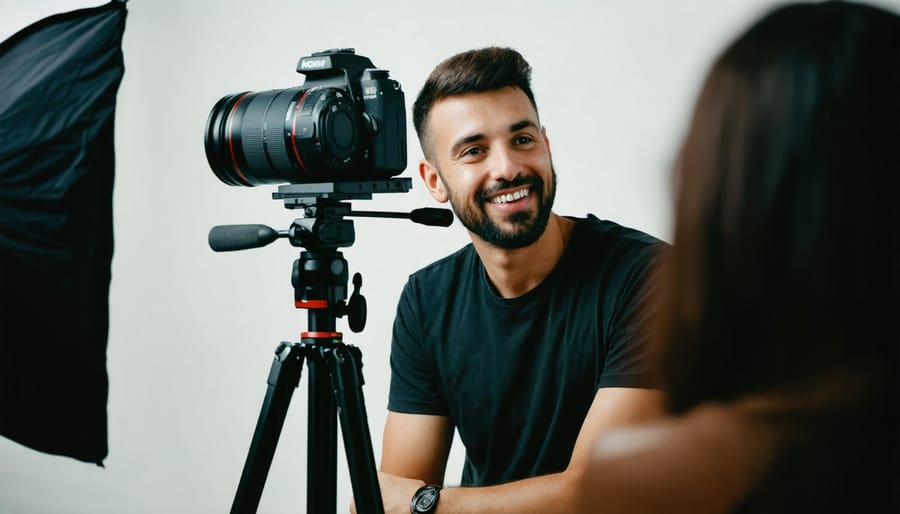
Pre-Shoot Communication
Clear communication before a photo shoot is the foundation of successful storytelling through photography. Start by having an open conversation with your subject about their expectations, concerns, and boundaries. This dialogue helps create a comfortable atmosphere and ensures both parties are aligned on the shoot’s direction.
Consider creating a simple pre-shoot questionnaire or checklist covering essential aspects like preferred shooting locations, wardrobe choices, and any specific moments or emotions they’d like to capture. This not only helps you prepare technically but also gives you valuable insights into their story.
Be transparent about how you plan to use the images and obtain necessary permissions upfront. Discuss whether the photos will be used for personal portfolios, social media, or commercial purposes. This builds trust and prevents misunderstandings later.
Remember to share your creative vision while remaining flexible to your subject’s input. Explain your storytelling approach in simple terms, perhaps using example photos from your portfolio to illustrate your style. This helps subjects understand what to expect and how they can contribute to the narrative.
Finally, establish practical details like timing, location logistics, and backup plans. This comprehensive preparation ensures everyone feels confident and ready to create meaningful images that tell authentic stories.
During and After the Shoot
Building trust doesn’t end when you start clicking the shutter. During the shoot, maintain open communication with your subject, explaining what you’re doing and why. If you notice someone becoming uncomfortable, take a break and address their concerns. Remember that your subject’s comfort will directly reflect in the final images.
Share previews of selected shots on your camera’s LCD screen to help your subject feel more involved and confident. This transparency builds trust and allows them to provide input on the direction of the shoot. However, be mindful not to overwhelm them with too many technical details or constant image reviews.
After the shoot, respect any agreements made about image usage and sharing. If you promised to let your subject review images before publication, honor that commitment. When editing, maintain the authenticity of the story – avoid excessive retouching that might alter the narrative’s truth or misrepresent your subject.
Keep your subject informed about how and where their images will be used. If the intended use changes, seek their permission first. This ongoing respect for their privacy and agency helps maintain trust and often leads to lasting professional relationships and future storytelling opportunities.
Practical Techniques for Ethical Storytelling
Environmental Context
The environment where you shoot can be as crucial to your story as the subject itself. Environmental storytelling through photography requires careful consideration of location and props to create authentic, compelling narratives. When selecting your shooting location, look for elements that naturally complement your subject’s story. A musician might be photographed in their practice space, surrounded by instruments and sheet music, while an artist could be captured in their studio amid works in progress.
Props should feel natural and relevant, never forced or staged. Instead of adding random objects, choose items that genuinely belong to your subject or reflect their daily life. For example, a chef’s hands kneading dough in their kitchen tells a more authentic story than the same person posed with cooking utensils in a studio setting.
Consider the interplay of light and architecture in your chosen location. Natural window light streaming into a workshop can create dramatic shadows that enhance the mood, while the texture of worn walls or vintage furniture can add layers of visual interest that support your narrative. Remember, the goal is to create an environment that feels lived-in and genuine, allowing viewers to step into your subject’s world naturally.
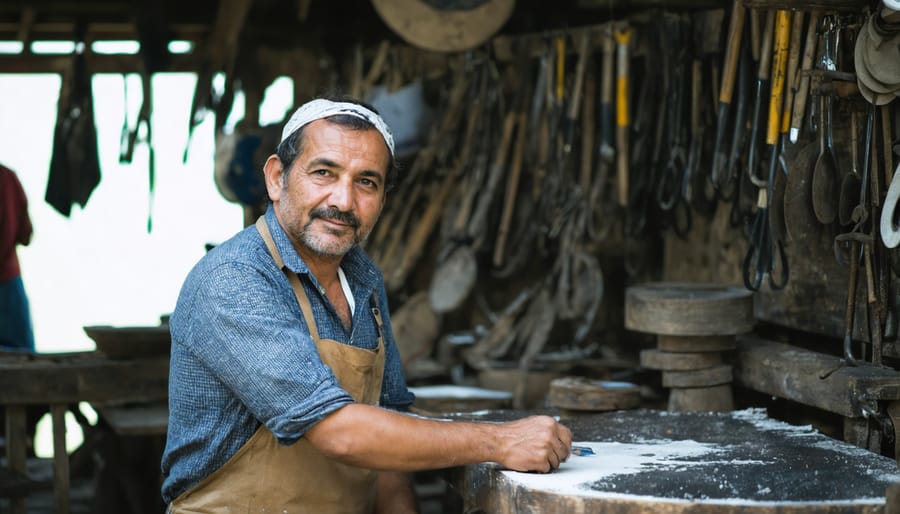
Subject Collaboration
Creating compelling photographic stories isn’t a solo endeavor – it’s a collaborative dance between photographer and subject. When you involve your subjects in the storytelling process, you unlock deeper, more authentic narratives that resonate with viewers on a profound level.
Start by having meaningful conversations with your subjects before the shoot. Ask about their experiences, memories, and what matters most to them. This dialogue helps establish trust and often reveals unique elements that can enrich your visual narrative. For instance, a musician might share a story about their first guitar, which could become a powerful prop in their portrait.
Consider showing your subjects the images during the shoot and getting their input. Their reactions and suggestions can lead to unexpected creative directions and ensure they feel represented authentically. This approach is particularly valuable in documentary and portrait photography, where the subject’s comfort and agency are paramount.
Remember to maintain open communication about how the images will be used and shared. Collaborate on selecting final images that both you and your subject feel tell the intended story effectively. This shared decision-making process not only respects your subject’s dignity but often results in more compelling, truthful photographs that capture genuine moments and emotions.
Post-Processing Ethics
In the digital age, post-processing has become an integral part of photographic storytelling, but it’s essential to maintain authenticity and ethical standards. While editing tools offer powerful ways to enhance your images, the goal should be to support and strengthen your narrative rather than create a misleading representation.
A good rule of thumb is to consider whether your edits maintain the integrity of the original moment. Basic adjustments to exposure, contrast, and color are generally acceptable and often necessary to accurately represent what you witnessed. However, dramatically altering key elements or removing/adding significant features can cross ethical boundaries, especially in documentary or journalistic work.
Be transparent about your editing process when sharing your work. If you’ve made significant creative alterations, consider mentioning this in your caption or presentation. This honesty builds trust with your audience and adds value to your storytelling approach.
Remember that different genres of photography have different ethical standards. Fine art photography may allow for more creative manipulation, while photojournalism requires strict adherence to reality. Whatever your chosen field, establish clear personal guidelines for post-processing that align with your storytelling goals and professional integrity.
Consider developing a consistent editing style that enhances your narrative voice while respecting the authenticity of your subjects and scenes. This approach helps maintain credibility while allowing your creative vision to shine through.
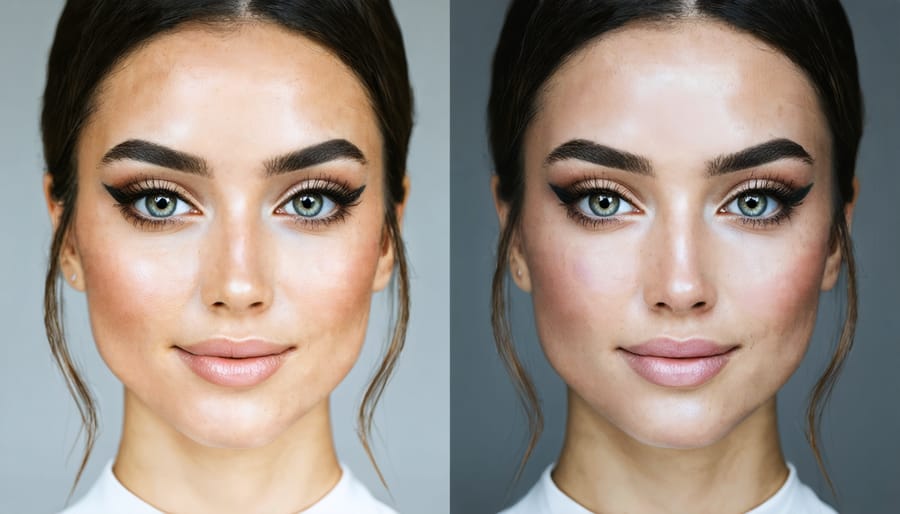
As we’ve explored throughout this article, storytelling through portrait photography is a powerful medium that requires both technical skill and ethical consciousness. The responsibility we carry as photographers extends beyond simply capturing beautiful images – we’re entrusted with preserving moments, sharing narratives, and representing our subjects with dignity and authenticity.
The key to ethical storytelling lies in building genuine connections with our subjects, obtaining informed consent, and maintaining transparency throughout the creative process. When we approach portrait photography with respect and empathy, we create images that not only resonate visually but also honor the trust placed in us by our subjects.
Remember that every portrait tells a story, whether it’s a candid street photograph or a carefully composed studio shot. The choices we make – from composition and lighting to post-processing decisions – all contribute to the narrative we’re sharing with the world. By staying true to our subjects’ stories while applying our artistic vision thoughtfully, we create photographs that stand the test of time.
The impact of ethical storytelling in portrait photography reaches far beyond the immediate moment of capture. These images become part of our collective visual history, influencing perceptions, challenging stereotypes, and fostering understanding between diverse communities. As photographers, we have the privilege and responsibility to contribute positively to this visual legacy while respecting the dignity and agency of those we photograph.

